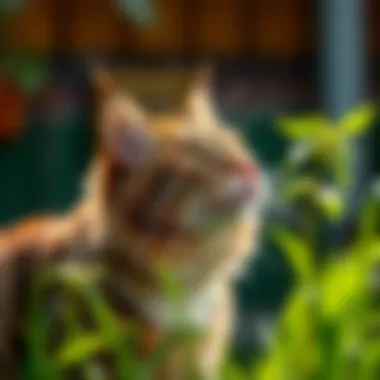Addressing Cat Spraying Issues: Understanding Solutions


Intro
The moment a cat starts spraying, it can feel like the calm before a storm, suddenly shifting the atmosphere in a home into a maze of confusion and frustration. Understanding this behavior is not just about selecting the right cleaning solution or stubbornly hoping for it to stop; it dives into the intricacies of feline psychology, their territory instincts, and the many factors that can trigger such actions.
For those who cherish their feline companions, witnessing this behavior can feel like a betrayal. Yet, grasping why a cat might feel compelled to spray can open the door to effective solutions and restore peace in your home. From evaluating their environment to understanding their health, this article explores a wealth of knowledge that cat owners can employ.
In the sections that follow, we’ll touch on vital elements like assessing pet care essentials, behavioral training, creating a pet-friendly environment, and spotting potential health issues. Each piece forms a puzzle to resolve the mystery behind problematic spraying and set a course toward a harmonious home life with your furry friend.
Prelude to Cat Spraying
Understanding cat spraying is an essential component for any pet owner trying to maintain harmony in their home. When a cat engages in this behavior, it can be both bewildering and frustrating for the human companions. Identifying the core reasons behind spraying helps in developing effective solutions, which can lead to a more peaceful environment for both the pet and their owner.
Defining Cat Spraying Behavior
Cat spraying, in its essence, is a behavior that involves a cat releasing urine in a vertical position, often on furniture, walls, or other surfaces, instead of using a litter box. This action is not merely a lack of training but rather a natural instinct that serves various functions in a cat's life. Spraying is primarily a means of communication among felines. Cats have scent glands located around their faces, paws, and the base of their tails, which are stimulated during this action, allowing them to mark their territory or signal availability to potential mates.
Distinction Between Spraying and Urination
It’s important to differentiate between cat spraying and regular urination. While both involve urination, they serve quite different purposes:
- Urination is generally a position-based act used for relieving oneself. A cat will squat and empty its bladder into the litter box or a similar surface. This behavior is usually consistent with a need to relieve pressure.
- Spraying, on the other hand, is a deliberate act that often involves a cat standing. It is typically associated with marking territory or expressing stress. Spraying can happen even when the cat has access to the litter box, making it more perplexing for owners.
Recognizing this difference is crucial. Many pet owners mistakenly assume that their cat is simply ignoring the litter box or is not trained, when in fact, they are communicating in a way intrinsic to their nature.
"Understanding the nature of cat spraying changes the way owners approach the behavior; it becomes less about defiance and more about communication."
In summary, the introduction of cat spraying outlines why this topic is essential for maintaining a peaceful living environment. By grasping these foundational concepts, cat owners can better navigate the challenges posed by this behavior, fostering a deeper relationship with their feline friends.
Common Causes of Cat Spraying
Understanding the common causes of cat spraying is crucial for pet owners facing this perplexing behavior. It allows them to see their feline friends not just as mischief-makers but as creatures communicating their needs and emotions. Recognizing these triggers can lead to effective solutions, fostering a more harmonious environment both for the cat and its human companions.
Territorial Marking
Territorial marking is one of the primary motivators for a cat to spray, especially in multi-pet households. Cats are inherently territorial creatures. When they feel their domain is being encroached upon—whether by a new pet, a neighborhood cat lurking outside, or even changes within the household—they may resort to spraying. This act sends a clear message: "This is my space!"
It’s not uncommon for cats to increase marking behavior during certain life stages, such as reaching maturity or feeling insecure. To mitigate this behavior, it’s helpful to provide designated spaces for each pet. Elevated perches, hiding spots, and scratching posts placed in various locations can help to ease territorial tensions.
Stress and Anxiety Factors
Much like humans, cats can experience stress and anxiety, and this emotional turmoil can lead to spraying. Changes in routine, like family members moving in or out, renovations, or even loud noises can shake a cat's sense of security. A stressed cat often seeks comfort and familiarity, and if it feels threatened or anxious, it may turn to spraying as a coping mechanism.
It’s essential to recognize the signs of stress in cats, which may include hiding, excessive grooming, or changes in eating habits. Creating a calm environment can help alleviate anxiety. Consider employing calming pheromone diffusers or engaging in more interactive play to distract and soothe your pet.
Medical Issues Linked to Spraying
While behavioral triggers are often the first culprits in cat spraying, don’t overlook medical issues. Urinary tract infections, kidney disease, or diabetes can cause increased urination or discomfort, leading to what may initially seem like spraying. Understanding these potential medical causes is key.
If a cat's spraying behavior changes suddenly or is accompanied by symptoms like straining to urinate or blood in the urine, consulting a veterinarian is imperative. Regular health check-ups can help catch any underlying issues before they escalate, aiding in the overall well-being of your feline companion.
Influence of Other Pets
The presence of other pets can significantly impact a cat's behavior, including its propensity to spray. New animals in the home, whether they’re a permanent addition or just visitors, can upset the established social dynamics. Cats may feel the need to assert their dominance through spraying to re-establish their territory, particularly in homes where the pets don’t get along well.
To ease the tension, gradual introductions between pets can be helpful. Creating separate areas for each cat can reduce territorial disputes and provide safe spaces for them to retreat. Consider utilizing vertical space—like cat trees or shelves—so they can observe each other from a distance before fully interacting.


"Cats are to be understood not just for their behavior but for the reasons behind it. By unraveling the complexities, we enhance our bond with them."
By acknowledging and addressing these common causes of cat spraying, owners can better navigate this behavior and work towards effective solutions directly tailored to their cats' needs.
Assessing Behavioral Triggers
Identifying the triggers of cat spraying behavior is crucial for addressing the issue effectively. Understanding these triggers gives pet owners valuable insight into their feline’s actions and allows them to implement tailored solutions. By assessing behavioral triggers, pet owners can grasp what might be causing stress or anxiety in their furry companions, thus taking necessary measures to restore peace in their home. This approach not only helps tackle the immediate problem but also fosters a stronger bond between cats and their owners.
Changes in Household Dynamics
Altering household dynamics can significantly affect cat behavior. This includes any shifts in the family structure, such as new additions to the family, be it a baby or another pet. Imagine a household where a new dog arrives. The resident cat might feel the need to assert its territory through spraying, showcasing its discomfort in the face of competition. Changes can also arise from human interactions—an unintentional adjustment in routine, like a parent spending more time at work or kids going away for college, may unsettle a sensitive cat.
- Feelings of insecurity: Cats, being creatures of habit, thrive on stability. A sudden absence of loved ones or a new environment can trigger anxiety, manifesting in behaviors like spraying.
- Resource competition: When new pets join the fold, cats may feel threatened as they perceive a competition for food, litter boxes, or even affection. This feeling of rivalry can lead to spraying as a means of marking their territory.
- Familiarity with unfamiliar beings: When a new baby is brought into the home, cats can become understandably uneasy. Their territory shrinks, and the new, unfamiliar sounds and smells can contribute to their anxiety.
Maintaining clear, consistent routines and introducing changes gradually can help alleviate stress and curb unwanted spraying behaviors.
Environmental Changes and Their Impact
Environmental elements play a pivotal role in influencing a cat's behavior. Any modifications, whether internal like rearranging furniture or external like construction noise nearby, can be distressing for sensitive felines. Environmental factors go beyond just physical surroundings; they encompass atmospheric shifts as well.
- Noise and disturbances: Sudden loud sounds like thunderstorms or renovations can create anxiety. A cat startled by a loud clatter may feel compelled to spray as a way of expressing its distress.
- Temperature fluctuations: Cats, much like humans, have their preferences and can feel uneasy in unsuitable conditions. Fluctuations between too hot and too cold can lead them to act out.
- New scents: The introduction of unfamiliar scents, perhaps from a newly purchased piece of furniture or a visitor, can provoke stress. Cats possess a keen olfactory sense, and even a subtle whiff of something out of the ordinary can unsettle them.
To mitigate these issues, observe the environment. Reflect on any recent changes and how they correlate with the onset of spraying behaviors. Providing a safe, secure area where cats feel at ease can significantly reduce their anxiety and inhibit the urge to spray.
The Role of Neutering and Spaying in Spraying Reduction
Neutering and spaying are terms frequently encountered in discussions surrounding cat behavior. These procedures do much more than control the feline population; they play a significant role in addressing cat spraying issues as well. The act of altering a cat's reproductive status can diminish territorial behaviors that often lead to unwanted marking within the home. Understanding this critical aspect can help owners tailor their approach for a more harmonious living environment.
How Neutering Affects Behavior
When a cat is neutered or spayed, it generally leads to a notable change in hormone levels, particularly testosterone in males and estrogen in females. These hormones significantly influence a cat's behaviors, including their inclination to spray. Neutered males often show considerably less interest in marking territory, as their natural instinct to establish dominance diminishes. Additionally, females that have been spayed tend to engage in fewer behaviors associated with mating and marking, which can cut down on the motivation to spray entirely.
Cats that are not spayed or neutered often become more agitated, restless, or anxious when hormones peak. This hormonal surge can lead to increased spraying behavior as a means to establish or defend their territory. After the alteration, many owners report a marked decrease in spraying incidents, leading to a calmer household and improved relationships between pets and their human companions.
Timing of Neutering Procedures
Timing is crucial when it comes to neutering or spaying. Procedures are typically recommended before a cat reaches sexual maturity, which occurs around six months of age. Taking this step early on can prevent many behavioral issues, including spraying. Research has shown that early spaying and neutering can lead to enhanced behavioral outcomes and reduced instances of spraying due to hormonal influences.
However, owners must also consider the individual circumstances surrounding each cat. Factors like breed, health status, and previous behavioral patterns should play a role in deciding the right time to proceed with the operation. In any case, consulting a veterinarian should be a priority, as they can provide tailored advice to ensure each cat receives the right care at the right moment.
Neutering and spaying offer not just relief from unwanted spraying behavior but also contribute to a broader strategy for managing cat behavior. By making knowledgeable decisions about these procedures, owners can navigate the challenges of cat spraying while promoting a joyful environment that enhances the wellbeing of both pet and owner.
Behavior Modification Techniques
Understanding cat spraying is essential for creating a peaceful home environment. Behavior modification techniques serve as tools to change your cat's behavior. These methods focus on addressing the root causes rather than merely combating the symptoms. By modifying behaviors effectively, one can restore harmony both for the pet and the owner.
Creating a Stress-Free Environment
A cat’s home should be a haven, yet various stressors can provoke undesirable behaviors like spraying. Creating a stress-free environment is not just about cleaning up messes; it entails a thorough assessment of your cat’s surroundings and interactions. Visual noise, such as sudden movements or a loud television, can startle your feline friend.
Consider these elements in crafting a calming atmosphere:
- Hide unattractive sights: Block views into potential stressors outside, like feral cats or dogs. Use plants or furniture strategically to obscure windows.
- Maintain a routine: Cats are creatures of habit. Feed and play with your cat at the same time daily to establish a predictable routine. This can markedly reduce anxiety levels.
- Shelters and safe spaces: Create cozy nooks or hiding spots within your home where your cat can retreat when feeling overwhelmed. Cat trees or covered beds provide comfort and security.
By facilitating a peaceful environment, you may dramatically reduce spraying and encourage contentment in your pet.


Utilizing Positive Reinforcement
Positive reinforcement involves rewarding desirable behaviors rather than punishing undesired ones. It encourages your cat to choose appropriate alternatives to spraying. Cats respond well when they associate good behavior with rewards.
Implementing positive reinforcement might involve the following steps:
- Identify triggers: Be observant when your cat displays behavior patterns leading to spraying. Once identified, you can counter these triggers with distractions or rewards.
- Use treats or affection: When your cat uses the litter box or engages in other good behaviors, provide treats or praise immediately. This builds a positive connection in your cat’s mind.
- Consistency is key: Make sure everyone in the household is on the same page. Mixed signals can confuse a cat and hinder progress.
By fostering an atmosphere that rewards good behavior, you can steer your feline companion away from spraying.
Redirecting Spraying Behavior
Redirecting is about channeling the unwanted behavior into something more acceptable. The aim here is to provide an alternate focus for the cat's energy and instinct.
You could consider the following strategies:
- Provide enrichment: Toys that stimulate mental and physical activities can divert your cat’s attention. Items such as feather wands or laser pointers can keep their hunting instincts satisfied without resorting to spraying.
- Playtime plans: Regularly engage with your cat through interactive play sessions. This could go a long way in alleviating the boredom or frustration that sometimes leads to spraying.
- Scheduled litter box breaks: If your cat has a habit of spraying at specific times, create a routine where they have access to the litter box before those times, encouraging its use beforehand.
By redirecting their energies wisely, you'll find that the likelihood of unwanted spraying behavior decreases.
"Redirecting a cat's natural instincts and energies can lead to improved behavior, more happiness, and less spraying."
Incorporating these behavior modification techniques into your cat care strategy can significantly aid in managing spraying issues. A combination of fostering a stress-free environment, rewarding positive behaviors, and redirecting impulses creates a multifaceted approach to addressing this challenging behavior.
Practical Solutions for Spraying
Addressing cat spraying is akin to solving a puzzle; every piece must fit together to restore balance in your home. Practical solutions play a vital role in not only managing the behavior but also enhancing the overall well-being of your feline companions. When pet owners take the time to understand and implement these strategies, they can create a sanctuary for their pets and themselves. The beauty of these solutions lies in their simplicity and effectiveness, tailored to address the unique needs of each cat.
Let’s explore some of these pragmatic approaches that can help alleviate the issue of spraying.
Use of Feline Pheromones
The application of feline pheromones can be a game changer for many cat owners. These are naturally occurring chemicals that cats use to communicate, signaling comfort and familiarity. Introducing pheromones into your living space provides a sense of calm for your cat. Products like Feliway mimic these pheromones and help to reduce anxiety, encouraging your cat to mark their territory in a more socially acceptable manner.
- How It Works:
- Usage:
- Prevention:
- Litter Box Calming: When a cat feels secure, they are less likely to spray. Positive pheromones can reduce their urge to engage in marking behavior.
- Sprays or Diffusers: Depending on your preference, you can use sprays in areas where spraying has occurred or diffusers that continuously release pheromones into the air.
- Regular use of these products can help prevent future outbreaks of spraying. Expect results over a few weeks, giving your cat time to adjust to the calming influences around them.
In essence, pheromones not only act as a preventive measure but also help reinforce a feeling of safety in the home environment.
Litter Box Management Strategies
A well-maintained litter box can make a world of difference for your cat. Sometimes, the simplest solutions have the most effective outcomes. Making adjustments to litter box management can significantly curb unwanted spraying behavior.
- Frequency of Cleaning:
- Number of Boxes:
- Type of Litter:
- Box Location:
- Cats are notoriously picky about cleanliness. Ensure that the litter box is scooped daily and fully cleaned weekly to prevent any aversion that might lead them to spray instead.
- A common rule of thumb is to have one litter box for each cat, plus one extra. This prevents territorial disputes among household cats and gives them easy access to a clean space when nature calls.
- Experiment with various types of litter - clumping, clay, or natural options. Cats have personal preferences, and finding the right one can help in encouraging appropriate behavior.


- The placement of the litter box is critical. Keep it in a quiet, low-traffic area where your cat can feel secure while doing their business. An inappropriate location can lead to anxiety and, consequently, increased spraying.
By managing these factors effectively, pet owners can help their cats feel more at ease, significantly reducing the chances of spraying as a form of stress response.
Implementing these practical solutions requires time and commitment, yet the rewards manifest in a happier and more harmonious living space for both cats and their humans. Try these strategies, and you may find that a calmer, more content cat is within reach.
"Patience is the key to understanding the behavior of our cats; they live in our homes, but ultimately, we must live in their world."
Professional Help and Intervention
When it comes to tackling the challenges posed by cat spraying, seeking professional help can sometimes be the most effective route. While many pet owners try to address the issue independently through various home remedies or behavioral modification techniques, there are instances where the expertise of a veterinarian or an animal behaviorist adds significant value to the process. Engaging these professionals can provide insight that goes beyond the usual advice, helping you understand the specific needs and underlying issues affecting your feline friend.
When to Consult a Veterinarian
Recognizing when to visit a veterinarian is crucial in addressing cat spraying behaviors. There are several indicators that may suggest a medical issue at play. If your cat suddenly begins spraying, especially if they have not exhibited this behavior before, it is essential to seek professional guidance promptly.
- Changes in Health: If the spraying is accompanied by other changes in behavior or signs of discomfort, such as straining to urinate or a decrease in appetite, these could be warning signs of urinary tract infections or other health concerns that require immediate attention.
- Age Considerations: Older cats may experience a range of health issues that could lead to behavioral changes. A thorough check-up can rule out any medical complications that might cause them to spray.
- Underlying Conditions: Conditions such as diabetes, hyperthyroidism, or kidney disease can influence your cat's urination habits, making it necessary for a vet to perform diagnostics to find the actual culprit behind the behavior.
In these cases, a veterinarian can not only treat medical issues but also provide reassurance and advice on behavioral management that considers your cat's well-being.
Involving Animal Behaviorists
Once medical issues have been ruled out, or if sprinking persists despite medical treatment, an animal behaviorist can be an outstanding ally in understanding and resolving the issue. These professionals specialize in assessing animal behavior and can help craft tailored solutions based on your specific circumstances.
- Behavioral Assessment: A behaviorist will often begin with a thorough assessment of your cat’s behavior in conjunction with their living environment. They will look for triggers that may be causing your pet to spray, whether they are environmental factors or patterns in interaction with their owners or other pets.
- Customized Solutions: After evaluation, the behaviorist can collaborate with you to implement a plan that might involve altering the environment, restructuring routines, and utilizing reinforcement strategies. They may also offer insights on the best practices to help your cat feel secure and reduce anxiety, which often underlies spraying behaviors.
- Long-Term Support: Behaviorists do not just provide a quick fix; they offer long-term strategies that are sustainable. Regular follow-ups can help ensure that the changes implemented remain effective, allowing you and your pet to find a harmonious living arrangement together.
Engaging these professionals can be a game changer in the process of addressing cat spraying issues. Their combined expertise can unearth solutions that most laypeople might overlook, providing a clearer path to resolving the spraying behavior successfully.
"Consulting with professionals can make all the difference, turning chaotic waterworks into calm tranquility for both you and your feline pal."
In summary, professional help in the form of veterinary care or animal behaviorists not only ensures that health issues are addressed but also provides comprehensive strategies for long-term behavior modification. This two-pronged approach will serve pet owners well, especially when navigating the complex world of cat behavior.
Long-Term Management Strategies
Long-term management of cat spraying issues is critical for establishing a peaceful coexistence between you and your feline companion. This approach extends beyond quick fixes, delving into sustainable practices that help address the root causes of spraying behavior. By implementing thorough and thoughtful strategies, not only can you mitigate current spraying incidents, but you can also prevent future occurrences. Here’s why long-term management strategies matter:
- Consistency is Key: Cats are creatures of habit; an inconsistent approach may lead them back to undesirable behaviors. A consistent long-term strategy reinforces appropriate behavior over time.
- Building a Trusting Relationship: Understanding and addressing a cat’s specific needs fosters a stronger bond. By engaging in these strategies, you promote a trusting communication pathway with your pet.
- Environmental Factors: Cats often respond to their surroundings. A well-structured environment reduces anxiety and promotes a sense of security. This may include designated areas for play and rest that don't encourage spraying.
- Monitoring Changes: Long-term strategies enable you to observe and document behavioral shifts. This vigilance can pinpoint triggers and make adjustments accordingly. By noting patterns, you can avoid potential reoccurrences.
Overall, investing time and effort into long-term management can transform not just your cat’s behavior but also the overall atmosphere of your home, allowing every household member to thrive.
Monitoring Behavior Over Time
When you decide to tackle the spraying issue in a cat, continuous monitoring becomes indispensable. Observing your cat allows you to catch potential problems early on. Here are some practical steps:
- Maintain a Behavior Log: Create a simple diary recording when and where spraying incidents occur. This will help you identify specific triggers or patterns.
- Daily Observations: Take note of your cat's mood and general behavior. Changes in appetite, playfulness, or aggression may play a role in the spraying and warrant further exploration.
- Track Environmental Changes: Note any adjustments in your home, including new pets, moving furniture, or changes in routine. These elements can cause stress, thus triggering spraying.
- Regular Vet Check-Ups: Beyond behavior, keep up with veterinary visits to ensure that health issues don’t contribute to spraying. Regular examinations can highlight underlying conditions.
Finale
In addressing the cat spraying issue, the importance of wrapping up our understanding cannot be understated. This final segment serves to consolidate all the insights gained from the previous discussions while providing a roadmap for pet owners grappling with this complicated behavior. The goal is not just to offer solutions but to also foster a harmonious living environment for both the owner and their feline companions.
Recap of Key Strategies
To tackle the cat spraying conundrum effectively, here are some crucial strategies that every pet owner should keep in mind:
- Understand the Behavior: Recognizing the difference between normal urination and spraying can help pinpoint the underlying causes. Spraying is often linked to stress or territorial issues.
- Address Environmental Stressors: Creating a peaceful home environment is essential. Changes in routine, moving to a new home, or the introduction of other pets can trigger unwanted behaviors.
- Consider Spaying or Neutering: This surgical intervention can significantly reduce spraying in unaltered cats, addressing hormonal influences on behaviors.
- Professional Guidance: Sometimes, it pays to bring in the experts. Consulting with a veterinarian or an animal behaviorist can provide tailored strategies and medical insights if there are underlying health concerns.
- Utilize Behavior Modification Techniques: Techniques like positive reinforcement for using the litter box or incorporating calming products such as feline pheromones can help redirect behaviors.
These strategies should be refined based on individual circumstances, and what works for one cat may not be effective for another.
The Importance of Patience and Understanding
Navigating the challenges posed by cat spraying is not a sprint; it's more like a marathon. Understanding that behavior change takes time is paramount. Cats are creatures of habit, and modification of long-held behaviors requires a steady hand and a calm approach. Here are a few considerations that highlight this point:
- Consistency: Sticking to a set of strategies is vital. Frequent changes can confuse the cat and exacerbate the issue.
- Empathy Towards the Pet: Viewing the situation from the cat's perspective is essential. Spraying may be their way of communicating distress or discomfort. Acknowledging their feelings can lead to more effective solutions.
- Long-Term Commitment: Sometimes, easing the problem can be as simple as introducing small changes gradually. Owners should remain vigilant and flexible, adjusting their strategies as they observe the cat's responses over time.







